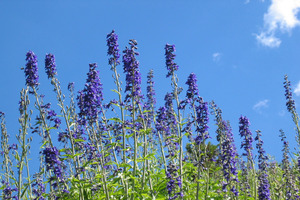Delphiniums are beautiful flowers that attract bees, hummingbirds, and butterflies to the garden. The flowers come in a wide variety of colors and people often pick them for cut flower arrangements. I personally love Delphiniums. Whenever I see them growing in the garden, I am reminded of English gardens. They have an elegant and stately beauty that few flowers can compare. The flowers grow on stalks, held high above the dark green foliage like a flag that commands attention. Depending on the variety chosen, they can grow from 2 feet tall to over 6-foot tall blooms. The blooming period for Delphiniums is late spring to early summer.
Delphiniums may look hard to grow, but they are really easy. And, if they have some winter protection, they will reseed themselves back every year. If you are growing the taller variety, you may need to stake the flowers to keep them from falling over and breaking off.
Location and Soil Preparation
Choose the right location grow your Delphiniums. They like full sun exposure with shade during the hot afternoon. Til or dig up the soil until it is loose and crumbly. Amend the soil with 3 to 4 inches of organic compost.
Level the soil with the tines of your rake. Remove any rocks, sticks, or hard dirt clods that your rake brings to the surface.
Planting Delphiniums
Dig the planting holes twice as wide as the rootball but keep the depth the same as the rootball. Remove the Delphinium from the container, being careful not to break the soil around rootball. These plants do not like their roots disturbed when transplanted, so you will want to minimize the shock and stress.
Place the rootball in the hole, making sure that the top of the rootball is level with the surrounding soil. Adjust the soil until you have it the right depth. Fill the planting hole with soil around the roots, gently firming the soil as your work. Space each plant according to the plant’s label. Each variety needs different spacing requirements.
Watering
Give the plants a good drink of water. Keep the soil moist, but not soggy. Provide about an inch of water each week, unless there is adequate rainfall in your area.
Mulch
Cover the soil with 3 or 4 inches of organic mulch. This helps the soil to maintain moisture and keep the weeds from growing.
Fertilizing
While the Delphiniums are actively growing, feed them with an all-purpose fertilizer every month. Read and follow label directions for proper application.
Deadheading
Deadhead the spent flowers early in the season. This helps prolong the blooming season and keeps the delphinium bed looking neat and tidy. If you want your plants to come back next year, leave the later flowers so they can go to seed.
After the first frost, cut back the Delphinium plants so they are 1 to 2 inches above the soil line. In the northern zones, cover the Delphinium with a layer of straw or I’ve often used leaves that I’ve raked from the yard. No matter which you use, it should be 3 to 4 inches deep. Mulching is a good idea because it helps protect the roots against heaving. When the ground freezes and thaws, it can push the roots out of the ground, killing your plants.
